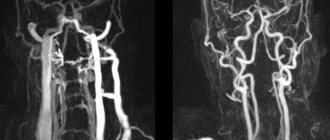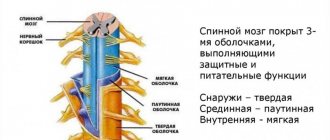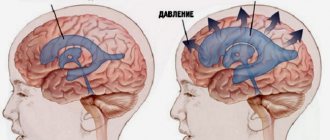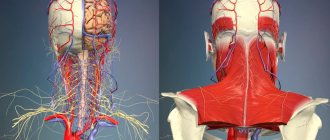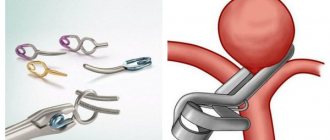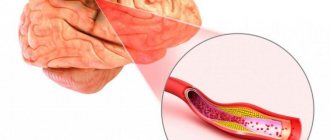Anatomy of the Human Cerebral Vessels - information:
The arteries of the cerebrum originate from the branches of a. carotis interna and a. basilaris, forming the circulus arteriosus cerebri at the base of the brain. The anterior, middle and posterior cerebral arteries branch on the surface of each hemisphere.
A. cerebri anterior supplies blood to the medial surface of the hemisphere up to the sulcus parietooccipitalis, on its outer surface to the superior frontal gyrus and the upper edge of the parietal lobe, and on the lower surface of the hemisphere to the gyrus rectus of the frontal lobe.
A. cerebri media supplies blood to the insula, both central gyri, the inferior frontal gyrus and most of the middle frontal gyrus, the parietal lobe and the superior and middle temporal gyri.
A. cerebri posterior branches on the medial, inferior and lateral surfaces of the temporal and occipital lobes, with the exception of the superior and middle temporal gyri.
The listed arteries, with their branches in the pia mater, form an arterial network, from which they penetrate vertically into the thickness of the medulla:
- cortical arteries - small branches that branch only in the cerebral cortex, and
- medullary arteries, which, after passing through the cortex, go into the white matter.
The central arteries enter from the base of the brain. Cortical, medullary and central arteries anastomose with each other, forming a single vascular network. The cerebellum receives blood from three arteries on each side.
Two a. cerebelli inferior anterior (branch of a. basilaris) and a. cerebelli inferior posterior (branch of a. vertebralis), branch on the lower surface of the cerebellum, the third branch, a. cerebelli superior (branch of a. basilaris), goes to its upper surface. From a. cerebelli superior is also supplied to the lower colliculi of the roof of the midbrain, and the superior colliculi receive their branches from a. cerebri posterior. The arteries of the remaining parts of the brain, related to the pons and medulla oblongata, originate from a. vertebralis, a. basilaris and their branches. In addition to the described arterial vessels, there are also special arteries of the choroid plexus, four in number on each side.
The cerebral veins are divided into superficial and deep. The superficial veins mostly collect blood from the cerebral cortex and flow partly into the sinus sagittalis superior (superior veins), partly (lower veins) into the sinus transversus and the sinuses of the base of the skull. The veins lack valves and are distinguished by their numerous anastomoses. The deep veins collect blood from the central gray nuclei and ventricles of the brain and merge into one large v. cerebri magna, flowing into the sinus rectus. The veins of the cerebellum form groups: the upper ones pour blood into the sinus rectus and v. cerebri magna, lower - in sinus transversus, sigmoideus, petrosus inferior.
Diseases due to circulatory disorders
In a healthy person, the middle part of the brain regulates blood supply to the brain. It also controls human breathing and the endocrine system. If he stops receiving nutrients, then the fact that a person’s blood circulation to the brain is impaired can be identified by the following symptoms:
- frequent attacks of headache;
- dizziness;
- difficulty concentrating, memory impairment;
- the appearance of pain when moving the eyes;
- the appearance of tinnitus;
- absence or delayed reaction of the body to external stimuli.
To avoid the development of an acute condition, experts recommend paying attention to the organization of the arteries of the head and neck of certain categories of people who, hypothetically, may suffer from a lack of blood supply to the brain:
- Children who were born by cesarean section and experienced hypoxia during intrauterine development or during labor.
- Teenagers are going through puberty, as their body undergoes some changes at this time.
- People engaged in increased mental work.
- Adults who have diseases accompanied by depletion of peripheral blood flow, for example, atherosclerosis, thrombophilia, cervical osteochondrosis.
- The elderly, since their vessel walls are prone to accumulation of deposits in the form of cholesterol plaques. Also, due to age-related changes, the structure of the circulatory system loses its elasticity.
To restore and reduce the risk of developing serious complications from subsequently impaired cerebral blood supply, experts prescribe medications aimed at improving blood flow, stabilizing blood pressure and increasing the flexibility of vascular walls.
Despite the positive effect of drug therapy, these medications should not be taken independently, but only with a prescription, since side effects and overdose threaten to worsen the patient’s condition.
Drugs to improve blood circulation
Poor blood supply to the brain of the head is a consequence of serious pathologies of the body. Typically, treatment tactics depend on the disease that causes difficulty in blood movement. Most often, blood clots, atherosclerosis, poisoning, infectious diseases, hypertension, stress, osteochondrosis, vascular stenosis and defects interfere with the proper functioning of the brain.
In some cases, to improve blood circulation in the brain, drugs are used that act to relieve the main manifestations of the pathology: headache, dizziness, excessive fatigue and forgetfulness. In this case, the drug is selected so that it has a comprehensive effect on brain cells, activates intracellular metabolism, and restores brain activity.
When treating poor blood supply, the following groups of drugs are used to normalize and improve the organization of the cerebral vascular system:
- Vasodilators. Their action is aimed at eliminating spasm, which leads to an increase in the lumen of blood vessels and, accordingly, a rush of blood to the brain tissue.
- Anticoagulants, antiplatelet agents. They have an anti-aggregation effect on blood cells, that is, they prevent the formation of blood clots and make it more fluid. This effect helps to increase the permeability of the walls of blood vessels and, accordingly, improves the quality of supply of nutrients to the nervous tissue.
- Nootropics. They are aimed at activating the functioning of the brain due to increased cellular metabolism, while those taking such drugs experience a surge of vitality, the quality of functioning of the central nervous system improves, and interneuronal connections are restored.
Taking oral medications in people with minor disorders of the organization of the circulatory system of the brain helps to stabilize and even improve their physical condition, while patients with severe circulatory disorders and pronounced changes in the organization of the brain can be brought to a stable state.
The choice of dosage form of medications is influenced by a large number of factors. So, in patients with severe manifestations of brain pathology, to improve blood supply, preference is given to intramuscular and intravenous injections, that is, using injections and droppers. At the same time, to consolidate the result, prevent and treat borderline conditions, medications are taken orally.
On the modern pharmacological market, the bulk of drugs to improve cerebral circulation are sold in the form of tablets. These are the following medications:
- Vasodilators:
Vasodilators. Their effect is to relax the walls of blood vessels, that is, relieve spasm, which leads to an increase in their lumen.
Correctors of cerebral circulation. These substances block the absorption and removal of calcium and sodium ions from cells. This approach prevents the work of spasmodic vascular receptors, which subsequently relax. Drugs with this effect include: Vinpocetine, Cavinton, Telektol, Vinpoton.
Combined cerebral circulation correctors. They consist of a set of substances that normalize blood supply by enhancing blood microcirculation and activating intracellular metabolism. They are the following drugs: Vasobral, Pentoxifylline, Instenon.
- Calcium channel blockers:
Verapamil, Nifedipine, Cinnarizine, Nimodipine. Focused on blocking the flow of calcium ions to the tissues of the heart muscle and their penetration into the walls of blood vessels. In practice, this helps to reduce the tone and relaxation of arterioles and capillaries in the peripheral parts of the vascular system of the body and the brain.
- Nootropics:
Drugs that activate metabolism in nerve cells and improve thought processes. Piracetam, Phenotropil, Pramiracetam, Cortexin, Cerebrolysin, Epsilon, Pantocalcin, Glycine, Actebral, Inotropil, Thiocetam.
- Anticoagulants and antiplatelet agents:
Medicines intended to thin the blood. Dipyridamole, Plavix, Aspirin, Heparin, Clexane, Urokinase, Streptokinase, Warfarin.
A frequent culprit of “hunger” of brain structures is atherosclerosis. This disease is characterized by the appearance of cholesterol plaques on the walls of blood vessels, which leads to a decrease in their diameter and permeability. Subsequently, they become weak and lose their elasticity.
Therefore, the use of restorative and cleansing drugs is recommended as the main treatment. These drugs include the following types of drugs:
- statins prevent the body from producing cholesterol;
- fatty acid sequestrants, blocking the absorption of fatty acids, while they force the liver to spend reserves on the absorption of food;
- Vitamin PP - dilates blood vessels, improves blood supply to the brain.
In addition, it is recommended to give up bad habits, fatty, salty and spicy foods.
How to improve blood circulation in the brain at home
Poor blood circulation to the brain can significantly impair a person’s quality of life and cause more serious diseases. Therefore, you should not ignore the main symptoms of the pathology and at the first manifestations of a blood supply disorder, you should contact a specialist who will prescribe competent treatment.
Along with the use of medications, he can also offer additional measures to restore the organization of blood circulation throughout the body. These include:
- daily morning exercises;
- simple physical exercises aimed at restoring muscle tone, for example, when sitting for long periods of time and in a hunched position;
- a diet aimed at cleansing the blood;
- use of medicinal plants in the form of infusions and decoctions.
Despite the fact that the content of useful substances in plants is negligible compared to drugs, they should not be underestimated. And if a sick person uses them independently as a preventive measure, then you should definitely tell the specialist about this at the appointment.
Folk remedies for improving cerebral blood supply and normalizing blood pressure
I. The most common plants that have a beneficial effect on the functioning of the circulatory system are the leaves of periwinkle and hawthorn. To prepare a decoction of them, 1 tsp is required. pour a glass of boiling water over the mixture and bring to a boil. Afterwards it is left to infuse for 2 hours, after which half a glass is consumed 30 minutes before meals.
II. A mixture of honey and citrus fruits is also used for the first symptoms of poor blood supply to the brain. To do this, grind them into a pasty state, add 2 tbsp. l. honey and leave in a cool place for 24 hours. For good results, you need to take this drug 3 times a day, 2 tbsp. l.
III. A mixture of garlic, horseradish and lemon is no less effective for vascular atherosclerosis. In this case, the proportions of mixing the ingredients may change. Take it 0.5 tsp. an hour before meals.
IV. Another surefire remedy for improving poor blood supply is an infusion of mulberry leaves. It is prepared as follows: 10 leaves are poured into 500 ml. boiling water and let it brew in a dark place. The resulting infusion is consumed instead of tea every day for 2 weeks.
V. For cervical osteochondrosis, rubbing the cervical spine and head can be done as an addition to the prescribed therapy. These measures increase blood flow in the vessels and accordingly increase blood supply to brain structures.
Gymnastics is also useful, including exercises for moving the head: bending to the side, circular movements and holding the breath.
Prevention
As a complement to the main treatment, preventing the underlying disease will help improve blood supply to the brain.
For example, if the pathology was caused by increased blood coagulation, then establishing a drinking regime will help improve well-being and improve the quality of the therapy. To achieve a positive effect, an adult needs to consume 1.5 to 2 liters of fluid daily.
If poor blood supply to brain tissue was caused by congestion in the head and neck area, then in this case, performing basic physical exercises to improve blood circulation will help improve your well-being.
All the steps below must be done carefully, without unnecessary movements or jerks.
- In a sitting position, place your hands on your knees and keep your back straight. Straightening your neck, tilt your head to both sides at an angle of 45%.
- This is followed by rotation of the head to the left, and then in the opposite direction.
- Tilt your head forward and back so that your chin first touches your chest and then looks up.
Gymnastics will allow the muscles of the head and neck to relax, while the blood in the brain stem begins to move more intensely through the vertebral arteries, which provokes an increase in its flow to the structures of the head.
You can also stabilize blood circulation by performing a head and neck massage with improvised means. So, you can use a comb as a handy “simulator”.
Eating foods rich in organic acids can also improve blood circulation in the brain. Such products include:
- Fish and seafood;
- oats;
- nuts;
- garlic;
- greenery;
- grape;
- bitter chocolate.
A healthy lifestyle plays an important role in recovery and improvement of well-being. Therefore, you should not get carried away with eating fried, highly salted, smoked foods, and you should completely stop drinking alcohol and smoking. It is important to remember that only an integrated approach will help improve blood circulation and improve brain activity.
